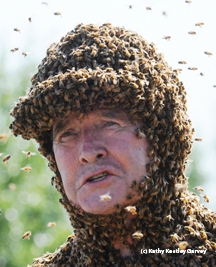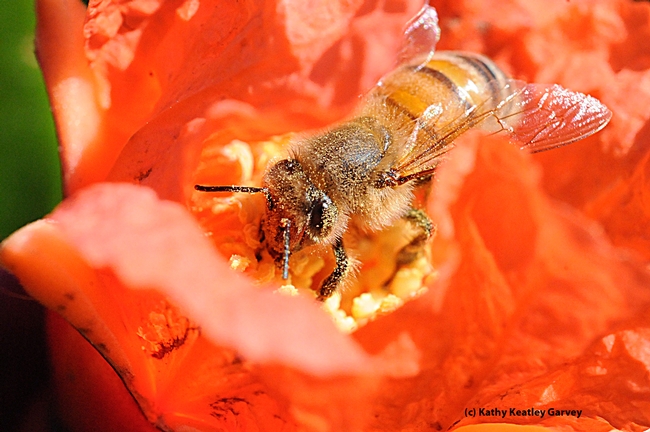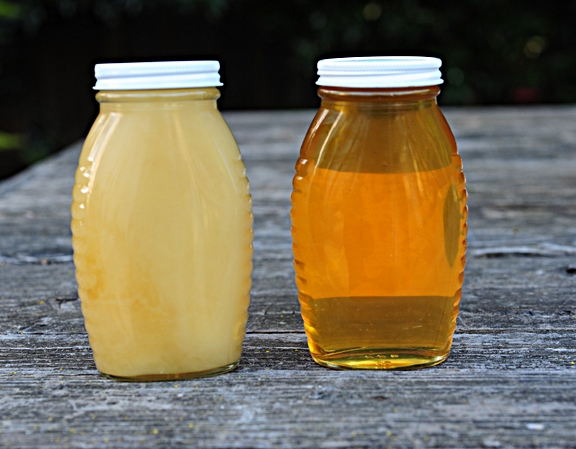
How many times have you heard that?
It did not go “bad” but it did granulate, as honeys do. Granulation is the formation of sugar (glucose) crystals. Reheat the honey and it’s good to go — and eat.
“Most honeys granulate during storage after extended periods of time in containers,” says honey bee specialist/bee wrangler/six-decade beekeeper Norman Gary, emeritus professor in the Department of Entomology at UC Davis and author of the best-selling beginning beekeeping book, Honey Bee Hobbyist: The Care and Keeping of Bees.
“Sometimes honey granulates while still sealed in the comb,” Gary says. ”The basic reason honey granulates is that the bees have dissolved more sugar in the solution — a process called super saturation — than it can hold during storage. The tendency to granulate is determined primarily by the concentration of glucose. Excess glucose forms crystals of glucose hydrate that aggregate in a lattice in the honey."
Eric Mussen, UC Cooperative Extension specialist in Department of Entomology at UC Davis, says that nearly every variety of honey granulates over time, “since it is a supersaturated sugar solution. Hazy, crystallized, or solidified honey is not spoiled. Loosen the cap and place the container in hot water – the honey will return to its liquid state with stirring. When the sugar crystals release free water in honey, it can ferment. At that point it cannot be salvaged.”
Short-bursts in the microwave are also a good way to liquefy honey, Gary says. He advocates heating the glass jars in 30-second intervals, stopping and stirring.
“Monitor the temperature so you don’t have to heat more than necessary to achieve liquefaction.” High temperatures can "cause chemical changes that some purists consider to be heat damage.” It can also change the delicate flavors and darken the honey.
Some honeys do not crystallize or crystallize so readily. Tupelo honey, produced from the nectar of tupelo trees, does not granulate, Gary says.
As for the taste of honey, Mussen points out that honey tastes sweeter than sucrose “since it contains free fructose, which tastes sweeter to us than does sucrose. There also is free glucose in honey, but that does not taste exceptionally sweet to us.”

“The colors and flavors of honey are properties of the nectar collected by the bees, not of the bees producing the honey,” Mussen says. “Climate impacts the nectar. Honey produced from alfalfa bloom can be transparent or 'water white;' golden, as in 'clover' honey, or significantly darker, approaching amber, when it is produced in northern Canada, mid-western U.S., or southern U.S., respectively. If you wish to find specific varieties of honey to compare, many varieties and sources can be found at http://www.honeylocator.com/, overseen by the National Honey Board.”
Mead is another term that puzzles folks. It's an alcoholic beverage made with honey.
“Honey is the basic source of sugar for the fermentation of mead," Mussen explains. "Meads can be dry or sweet, depending upon the desire of the mead maker. With the addition of spices or fruit juices, meads are called various names: metheglin, hippocras, cyser or pymet.”
And, if you cook with honey, be aware of the properties.
“In baking and beverages honey often can be substituted directly for sugar,” Mussen says. “Lighter colored honeys usually are milder tasting, while the darker honeys are more robust. That is not always the case. Honey has around 17 percent water content, so for baking, it sometimes is good to reduce the volume of other liquids in the recipe. Also, honey tends to turn brown when baking, so reduce the heat by 25 degrees or so if less browning is desired. The finished baked product is apt to remain 'fresh' (moist) longer than sugar-based recipes, due to the presence of free fructose that attracts water moisture. Lining the measuring cup with a very thin film of cooking oil will let the honey slip right out, instead of sticking in the cup."
If you’re anxious to sample different honey varietals, head over Briggs Hall during UC Davis Picnic Day on April 20. Mussen will be offering his traditional free honey tasting. Last year he provided six kinds of honey: California buckwheat, avocado, eucalyptus, sage, orange, and cactus. In the past, visitors also tasted cotton honey, blackberry honey and starthistle honey and others.
Starthistle (Centaurea solstitialis), native to Eurasia is an exotic invasive weed hated by just about everybody but the beekeepers and the lovers of starthistle honey.
“Starthistle honey is the champagne of honey,” said Yolo County beekeeper Dennis Price of Good Bee Apiary. “It’s the best there is. However, this year’s starthistle may not be so good due to the lack of rain."
Like to cook with honey? Try the time-tested recipes on the National Honey Board website.
Beekeeper Kim Flottum, editor of Bee Culture magazine and author of the book, The Backyard Beekeeper, offers a number of recipes in his book, including these two toppings--just in time for spring!
Orange honey butter for cornbread
1/2 cup unsalted butter, at room temperate
1/8 teaspoon salt, or to taste
1 tablespoon orange zest, finely grated (1 medium to large orange)
1 tablespoon honey
Prepared corn bread
Put the softened butter into a bowl with the salt and whisk until creamy. Whisk in the orange zest and then the honey. Whisk until smooth. Warm cornbread at 250 degrees for 5 to 10 minutes. Remove from the oven and brush with a little orange honey butter. Col about 15 minutes before cutting into wedges. Serve with the remaining butter.
Orange cream spread
1 package (8-ounce) cream cheese
1/4 cup honey, mild
2 tablespoons orange juice
1/2 teaspoon orange peel or zest
Combine softened cream cheese, honey, orange juice, and orange peel. Blend well. Refrigerate at least one hour—overnight is better. Spread on rolls, muffins or croissants.
Attached Images:

